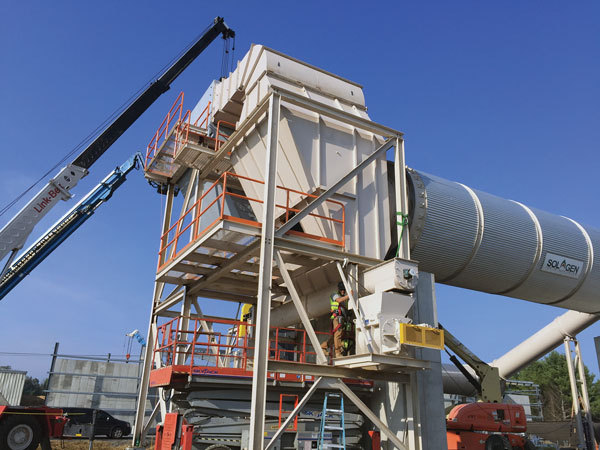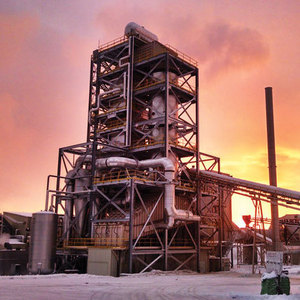Powering Up New Feedstock Demand







PHOTO: SOLAGEN
July 25, 2017
BY Tim Portz
Nearly 90 percent of Maine is blanketed in dense forests, and the state boasts nearly 40 species of trees that have commercial value. The Linkletter family has been working in these woods for four decades, logging, trucking and manufacturing wood pellets. Like everyone else who is economically dependent upon Maine’s forests and forest products industry, the family has worked continuously to anticipate and react to the industry’s continual evolutions.
Both pulp and paper manufacturing and sawmilling have been on a slow decline for years, constraining opportunities for private and institutional landowners and the logging community. In 2006, the Linkletter family took matters into their own hands, and began to investigate the economic viability of pellet manufacturing as a means of shoring up withering fiber demand. The Linkletters engaged Oregon-based Solagen, a hardware manufacturer and wood pellet manufacturing consultancy, to design and build a 100,000-ton-per-year facility for them near Athens. In April 2007, the facility began operations, and demand was robust. “Sometimes, we’d have trucks waiting,” says Scot Linkletter, plant manager at the facility.
Not long after the facility opened, bottlenecks were identified. Plant operators quickly exhausted the plant’s 12-ton-per-hour drying capacity, as well as the reserve capacity that the Solagen team designed into the plant, and now regularly requires 16 to 20 tons per hour. “They used that [reserve capacity] up 10 years ago,” says Francis Sharron, president at Solagen.
The facility achieved a high-water mark of 117,000 tons of production, and the Link-letters began evaluating options to remove some bottlenecks and increase their overall capacity. “Five years after the facility was commissioned, the Linkletters considered building a stand-alone pre-dryer to increase production at the plant,” Sharron says. “The facility was doing well, and they had landed a couple of good bulk customers in the area as well.”
The plant’s bottlenecks were most pronounced in the winter months when the facility’s inbound green material, at around 50 percent moisture, would freeze. Sharron explains that before the moisture in frozen sawdust and chips can be driven off, it must be thawed and converted back to water. This process requires energy—144 Btu to convert one pound of ice to one pound of water. “I don’t remember specific numbers all the time, but that number is one I certainly do,” says Sharron. Converting water from a solid to a liquid is called a phase change, and this phase change energy requirement constrained an already limited supply of drying power—another 15 percent in the winter months.
Compounding this problem in the winter were the higher electricity costs Maine Woods would encounter. Pellet presses consume massive amounts of electricity, and three years ago, prices got so high that the plant idled production because the cost of making pellets was more than what they could sell them for. Having to roll out of production in the middle of the heating season frustrated the Linkletters, and they began thinking of ways to work around these new operational challenges.
Changing Market Dynamics
At about the same time, it was becoming evident that the optimistic pellet market projections that had been stoking the Linkletter’s debottlenecking and plant expansion conversations were not likely to come to pass.
“When the facility was being built and commissioned, heating oil prices were still relatively high,” Sharron says. “However, many of the area’s potential bulk customers who were considering wood pellet systems opted for a different heating solution. Trucks carrying compressed natural gas were beginning to deliver fuel into the area, and it became clear that a good share of the bulk business everyone was anticipating just wasn’t going to materialize.”
Regardless of the prices of heating oil and natural gas, or the market’s embrace of wood heat systems, the forests near Athens continued to grow, and the Linkletters once again realized they needed to produce their own demand center. This time, they hoped they could arrive at an end use that could simultaneously introduce some new demand for fiber while also solving a few of the pellet facility’s operational constraints. Once again, Sharron and the team at Solagen were brought in to help.
“We’ve maintained a close relationship with Maine Woods because we answer ongoing O&M questions, sell them some replacement parts, and provide some service on the energy side of the pellet plant,” Sharron says.
Together, Solagen and Maine Woods began staking out what they wanted from a project. “We really worked to introduce a systematic decision making process into the discussion,” Sharron says. The Linkletters expressed interest in power production, and the team started investigating available technologies to accomplish this goal.
One of the constraints that both Solagen and Maine Woods had to keep top of mind was the labor shed in the area. Skilled labor, particularly licensed and ticketed high-pressure boiler operators, are in short supply in the rural area, and both parties wanted to avoid having to include the type of salary that thought would be needed to attract such a professional into the project pro-forma. “We kind of focused on one solution that seemed to make the most sense,” Sharron says. “Rather than use a high-pressure steam boiler that will give you higher efficiencies on the generating side, the idea was to supply them with an atmospheric pressure thermal oil boiler. Because the boiler runs at atmospheric pressure, we were able to avoid some really high personnel costs, saving on the order of $300,000 to $500,000 on staffing alone.”
Staffing wasn’t the only obstacle that a low-pressure solution offered. The project team was able to eliminate some permitting challenges that a high-pressure solution would have introduced.
Additionally, on the property there is a slow-moving stream that the project team was concerned would be warmed too much with boiler blow down water. “There is no blow-down associated with this thermal oil plant,” Sharron.
Solagen designed the system to capture waste heat exiting the thermal oil boiler via its stac,k and repurpose that heat to pre-dry the furnish that would ultimately flow into the pellet presses. “The idea was that it was going to add an additional 4 to 6 tons of drying capacity to the pellet plant at virtually no resource cost to improve the production efficiencies in the pellet plant,” Sharron says. “By putting in this dryer to use boiler stack gas to recover all of the waste heat off the thermal oil boiler, while also using a combustion air preheater in the system, we were able to qualify for a boiler efficiency of 100 percent, which is basically unheard of, by adding all of these other uses for the waste heat.”
ORC for Power Production
For the power generation component of the project, the team decided upon an organic Rankine cycle (ORC) turbogenerator supplied by Turboden, an Italian company that is part of the Mitsubishi Heavy Industries Group.
Solagen tells Pellet Mill Magazine that while ORC technologies are relatively new in the U.S., they can be found in Canada, and certainly in Europe. “Again, steam boilers are just very expensive to operate because of the licensing requirements,” Sharron says. “That is why thermal fluid is so popular.”
The lifeblood of the installed system at Maine Woods is a cyclopentane, a hydrocarbon with a number of industrial applications. “This entire system is a bit like a refrigerator running backwards,” Sharron says. “We evaporate this thermal oil under pressure, and the resulting pressure spins a turbine, which spins a generator to produce electricity. The thermal oil is recondensed, and the system begins again.
One of the key differences between turning an electric turbine with vaporized cyclopentane as opposed to vaporized water is the higher molecular weight of the thermal oil allows for the turbine to spin at far lower RPMs. “It is essentially like having heavy water,” Sharron says. A conventional steam turbine will spin at anywhere from 7,000 to 12,000 RPMs, while the turbine in the ORC skid turns at just 3,600 RPMs. “We’re talking about orders of magnitude difference between the two solutions,” Sharron says.
Lower RPM rates reduce the wear and tear on turbine blades and turbine assembly, and prolong the useful turbine life between maintenance events. This value aligned perfectly with the lighter maintenance footprint the project team was pursuing.
Finally, when it was time to commission the facility, the ORC turbogenerator set performed as advertised. “The equipment started right up,” Sharron says. “The commissioning process went very, very well. We’ve been involved in a number of other biomass plants and comparatively, this one went very well.”
Pieces of the Puzzle
For Sharron, the biomass power project at Maine Woods was a case study in numerous important parties coming together and delivering on their aspect of the project. Additionally, many of the larger capital expenditures were made outside the typical parameters of a standard EPC contract. This approach, too, was a costs savings measure. “We shared with Maine Woods early on that for this entire project to be economically viable, we needed to get a good owner’s engineer on board to help procure some of these larger items,” Sharron says. The project’s material handling systems, cooling towers, and the Turboden power skid were all sourced directly by Maine Woods. “This drove millions of dollars of expense out of the project,” he says.
The project also got a significant boost from a local environmental consultant who was brought on to help navigate the permitting requirements and the generation of the Tier 1 Renewable Energy Credits that were key to making the economics of the project work out. Additionally, the Mid-South Engineering office in Millinocket was engaged to manage the interconnection, metering and interfacing with Central Maine Power, the utility that the produced power was sold to. “This can be onerous,” Sharron says. “It can be very, very difficult, and it can be the difference between success and failure for projects like this.”
Altogether, Sharron estimates the project cost Maine Woods between $30 million to $35 million. It was brought online in August of last year in a limited basis, and in February, finally running near the 7.1 MW outlined in the power purchase agreement. “We’ll know more about the efficiencies we’ve introduced into the pellet operation later this fall,” Linkletter says. At that time, both the pellet facility and the power facility are allowed to run at full song, together.
The stakes of the project are not lost on Sharron. “For a small, privately owned company like Maine Woods to spend between $30 million and $40 million dollars, and then the project doesn’t work out, it’s not good,” Sharron says. But Sharron’s overall confidence in the project is high. He points to the systematic approach that he and other members of the project team took in identifying the project goals, budget and how to make the financial and operational goals for the project align. “The success of the project was bringing together a team of people, who had very high levels of expertise in certain areas. They accomplished a lot,” he says of the Linkletter family. “It amazes me that they’ve been able to do what they’ve done.”
Author: Tim Portz
Executive Editor, Pellet Mill Magazine
701-738-4969
tportz@bbiinternational.com
Advertisement
Advertisement
Upcoming Events





